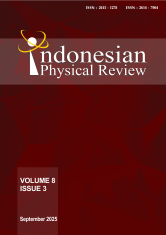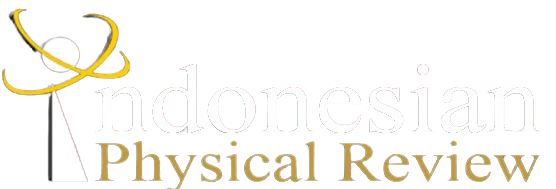SEA-LEVEL VARIABILITY IN THE JAVA SEA LINKED TO MONSOON FORCING AND CLIMATE TELECONNECTIONS (2009–2024)
DOI:
10.29303/ipr.v8i3.571Downloads
Abstract
The Java Sea is a shallow, strait-connected shelf where seasonal monsoon forcing and climate modes can strongly modulate sea level, yet their sectoral expressions remain under-resolved. Altimetric observations from 2009–2024 (DUACS) are analyzed and validated against a network of Indonesian tide gauges and partition the basin into western (W-JS), central (C-JS), and eastern (E-JS) sectors. After detrending, the seasonal cycle is diagnosed via amplitude and phase metrics and quantifies interannual teleconnections using lead–lag cross-correlations (−12 to +12 months) between sea-level anomaly (SLA) and the Dipole Mode Index (DMI) and Southern Oscillation Index (SOI), with confidence intervals. DUACS reproduces tide-gauge variability with high skill (median correlation ≈ 0.82; RMSE 5–11 cm; small negative biases), supporting its use as a basin proxy. Seasonally, SLA peaks in DJF, weakens in MAM, reaches a pronounced minimum in JJA, and recovers in SON, with marked zonal heterogeneity: E-JS exhibits the strongest annual range (~18 cm) versus W-/C-JS (~12–13 cm). The seasonal phase is non-synchronous (W-JS maxima in May–June; E-JS in December–January), while C-JS behaves as a transition zone. Interannually, IOD impacts are near-synchronous and negative (lag-0, r ~ −0.41 to −0.47 across sectors), whereas ENSO peaks at short positive lags (SOI leads by ~1 month; r ~ 0.45–0.53), implying higher sea level during La Niña and lower during El Niño. These sign-and-lag relationships, combined with tide and surge information, have the potential to inform seasonal outlooks for ports and low-lying coastal areas of Java.
Keywords:
Java Sea sea level DUACS altimetry ENSO IODReferences
[1] S. Seftiani, I. A. P. Putri, I. Hidayati, L. K. Katherina, V. Ningrum, and D. Vibriyanti, “Climate change and COVID-19: The double whammy for coastal communities in Demak, Indonesia,” in IOP Conference Series: Earth and Environmental Science, 2021.
[2] P. J. Ward, M. A. Marfai, F. Yulianto, D. R. Hizbaron, and J. C. J. H. Aerts, “Coastal inundation and damage exposure estimation: A case study for Jakarta,” Natural Hazards, vol. 56, no. 3, pp. 899 – 916, 2011.
[3] A. Wicaksono and H. Herdiansyah, “The impact analysis of flood disaster in DKI Jakarta: Prevention and control perspective,” in Journal of Physics: Conference Series, 2019.
[4] M. A. Marfai and L. King, “Potential vulnerability implications of coastal inundation due to sea level rise for the coastal zone of Semarang city, Indonesia,” Environmental Geology, vol. 54, no. 6, pp. 1235 – 1245, 2008.
[5] L. Nurhidayah, “Sea-level rise (SLR) and its implication on human security and human rights in indonesia: A legal analysis,” Springer Climate, pp. 33 – 52, 2021.
[6] K. Ichikawa, “Mean Seasonal Sea Surface Height Variations in and around the Makassar Strait,” Remote Sens (Basel), vol. 15, no. 17, 2023.
[7] A. Wirasatriya et al., “Ekman dynamics variability along the southern coast of Java revealed by satellite data,” International Journal of Remote Sensing, vol. 41, no. 21, pp. 8475 – 8496, 2020.
[8] E. Y. Handoko, L. K. Naibaho, D. Saptarini, and Yuwono, “Sea Level Variability around the Java Sea (study Area: Northern of Gresik and Surabaya) using Cryosat-2 Altimeter,” in IOP Conference Series: Earth and Environmental Science, 2021.
[9] A. S. Delman, J. L. McClean, J. Sprintall, L. D. Talley, and F. O. Bryan, “Process-Specific Contributions to Anomalous Java Mixed Layer Cooling During Positive IOD Events,” Journal of Geophysical Research Oceans, vol. 123, no. 6, pp. 4153 – 4176, 2018.
[10] T. F. Xu et al., “Observed Water Exchange Between the South China Sea and Java Sea Through Karimata Strait,” Journal of Geophysical Research Oceans, vol. 126, no. 2, 2021.
[11] G. Taburet et al., “DUACS DT2018: 25 years of reprocessed sea level altimetry products,” Ocean Science, vol. 15, no. 5, pp. 1207–1224, Sep. 2019.
[12] M. Passaro, Z. A. Nadzir, and G. D. Quartly, “Improving the precision of sea level data from satellite altimetry with high-frequency and regional sea state bias corrections,” Remote Sensing of Environment, vol. 218, pp. 245 – 254, 2018.
[13] M. Pirooznia, M. R. Naeeni, and T. Yousefzadeh, “Point-wise determination of vertical deformation at southern coastal areas of Caspian sea by combination of satellite altimetry and tide gauge observations,” Annals of Geophysics, vol. 63, no. 6, pp. 1 – 19, 2020.
[14] Husnayaen et al., “Physical assessment of coastal vulnerability under enhanced land subsidence in Semarang, Indonesia, using multi-sensor satellite data,” Advances in Space Research, vol. 61, no. 8, pp. 2159 – 2179, 2018.
[15] C. E. J. van Bijsterveldt et al., “Subsidence reveals potential impacts of future sea level rise on inhabited mangrove coasts,” Nature Sustainability, vol. 6, no. 12, pp. 1565–1577, Dec. 2023.
[16] A. Wirasatriya, R. D. Susanto, K. Kunarso, Abd. R. Jalil, F. Ramdani, and A. D. Puryajati, “Northwest monsoon upwelling within the Indonesian seas,” International Journal of Remote Sensing, vol. 42, no. 14, pp. 5437 – 5458, 2021.
[17] H. A. Rachman et al., “Dynamics of upwelling variability in the southern Indonesia region revealed from satellite data: Role of ENSO and IOD,” Journal of Sea Research, vol. 202, 2024.
[18] R. Y. Setiawan, A. Wirasatriya, U. Hernawan, S. Leung, and I. Iskandar, “Spatio-temporal variability of surface chlorophyll-a in the Halmahera Sea and its relation to ENSO and the Indian Ocean Dipole,” International Journal of Remote Sensing, vol. 41, no. 1, pp. 284 – 299, 2020.
[19] R. D. Susanto and R. D. Ray, “Seasonal and Interannual Variability of Tidal Mixing Signatures in Indonesian Seas from High-Resolution Sea Surface Temperature,” Remote Sensing, vol. 14, no. 8, 2022.
[20] E. Y. Handoko, H. Hariyadi, and A. Wirasatriya, “The ENSO’s Influence on the Indonesian Sea Level Observed Using Satellite Altimetry, 1993 - 2016,” in Proceedings - 2018 IEEE Asia-Pacific Conference on Geoscience, Electronics and Remote Sensing Technology: Best Practice for Disaster Mitigation using Geoscience, Electronics, and Remote Sensing, AGERS 2018, 2018.
[21] E. Y. Handoko, D. S. Richasari, and D. G. Pratomo, “Seasonal and Interannual Variability of Sea Level in the Indonesian Seas using Satellite Altimetry,” in IOP Conference Series: Earth and Environmental Science, 2021.
[22] A. Nurlatifah, Martono, I. Susanti, and M. Suhermat, “Variability and trend of sea level in southern waters of Java, Indonesia,” Journal of Southern Hemisphere Earth Systems Science, vol. 71, no. 3, pp. 272 – 283, 2021.
[23] A. Fadlan, D. N. Sugianto, Kunarso, and M. Zainuri, “Influence of ENSO and IOD on the Variability of Sea Surface Height in the North and South of Java Island,” in IOP Conference Series: Earth and Environmental Science, 2017.
[24] R. Rachmayani, N. S. Ningsih, F. Hanifah, and Y. Nabilla, “Long-Term Trend and Variability of Volume Transport and Advective Heat Flux through the Boundaries of the Java Sea Based on a Global Ocean Circulation Model (1950–2013),” Water (Switzerland), vol. 15, no. 4, 2023.
[25] F. Jamil, Sakka, and D. Berlianty, “ENSO impacts during west and east monsoon to the ocean current and water mass characteristics in the Makassar Strait,” in IOP Conference Series: Earth and Environmental Science, 2019.
[26] N. A. Fekranie, A. Setiawan, and M. R. Putri, “Variability of Indonesian Throughflow Transport in the Indonesian Seas during Triple-Dip la Niña,” in IOP Conference Series: Earth and Environmental Science, 2024.
[27] L. A. Ruiz Etcheverry, M. Saraceno, A. R. Piola, G. Valladeau, and O. O. Möller, “A comparison of the annual cycle of sea level in coastal areas from gridded satellite altimetry and tide gauges,” Continental Shelf Research, vol. 92, pp. 87–97, 2015.
License

This work is licensed under a Creative Commons Attribution-NonCommercial-ShareAlike 4.0 International License.
Authors who publish with Indonesian Physical Review Journal, agree to the following terms:
- Authors retain copyright and grant the journal right of first publication with the work simultaneously licensed under a Creative Commons Attribution-ShareAlike 4.0 International Licence (CC BY SA-4.0). This license allows authors to use all articles, data sets, graphics, and appendices in data mining applications, search engines, web sites, blogs, and other platforms by providing an appropriate reference. The journal allows the author(s) to hold the copyright without restrictions and will retain publishing rights without restrictions.
- Authors are able to enter into separate, additional contractual arrangements for the non-exclusive distribution of the journal's published version of the work (e.g., post it to an institutional repository or publish it in a book), with an acknowledgment of its initial publication in Indonesian Physical Review Journal.
- Authors are permitted and encouraged to post their work online (e.g., in institutional repositories or on their website) prior to and during the submission process, as it can lead to productive exchanges, as well as earlier and greater citation of published work (See The Effect of Open Access).





